|
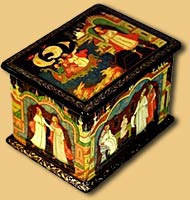 Russian
lacquer boxes are among the most beautiful and distinctive
of that country's art achievements in the 20th century. The
boxes feature intricately hand-drawn miniature paintings based
on a variety of themes, including fairy tales, poems, country
life, troikas, landscapes, battle scenes, and old art masterpieces.
They get their name from the many layers of lacquer (most
often, black and red) that are applied to both their outside
and inside sections. Coats of clear lacquer, or varnish, are
the last layers to be put on and provide a stunning shine
to the box. Russian
lacquer boxes are among the most beautiful and distinctive
of that country's art achievements in the 20th century. The
boxes feature intricately hand-drawn miniature paintings based
on a variety of themes, including fairy tales, poems, country
life, troikas, landscapes, battle scenes, and old art masterpieces.
They get their name from the many layers of lacquer (most
often, black and red) that are applied to both their outside
and inside sections. Coats of clear lacquer, or varnish, are
the last layers to be put on and provide a stunning shine
to the box.
|
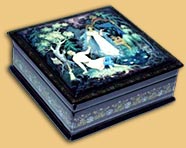 The
boxes, which vary in size, are extremely well crafted. It can
take as long as two months to make a box out of papier-mache,
a material many artists prefer because of its ability to withstand
changes in atmospheric conditions and to avoid cracking. The
lacquer box sitting on your mantel today will likely be enjoyed
by many generations. The
boxes, which vary in size, are extremely well crafted. It can
take as long as two months to make a box out of papier-mache,
a material many artists prefer because of its ability to withstand
changes in atmospheric conditions and to avoid cracking. The
lacquer box sitting on your mantel today will likely be enjoyed
by many generations.
|
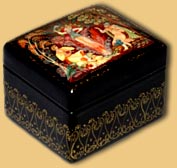 But
it's the miniature paintings that bring real value to the boxes.
Lacquer artists must not only excel artistically, but must also
have the patience to spend long stretches of time working on
the many small intricate sections of their composition. Artists
will typically use strong magnifying glasses on these spots
and very fine brushes made out of a squirrel's tail. But
it's the miniature paintings that bring real value to the boxes.
Lacquer artists must not only excel artistically, but must also
have the patience to spend long stretches of time working on
the many small intricate sections of their composition. Artists
will typically use strong magnifying glasses on these spots
and very fine brushes made out of a squirrel's tail.
The boxes most widely sought after come from one of four
small Russian villages - Palekh, Fedoskino, Kholui, and Mstera.
Special schools have been established at these places where
artists train for four years before they become members of each
village's art community. Each village also has its unique style.
|

|
|
Fedoskino
The village of Fedoskino, one of the centers of modern
Russian lacquerwork, is located in picturesque surroundings
of Moscow, on a bank of the Ucha.
Fedoskino is a very old village - about two hundred years
renowned for its miniature paintings on lacquered papier-mache
boxes.
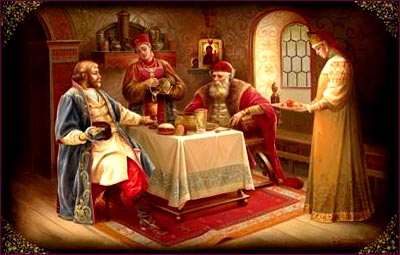
A characteristic feature of Fedoskino miniature painting
has always been a combination of direct painting with glazes
superimposed over a goldleaf, mother-of-pearl plaque or over
a ground powdered with metal dust.
|
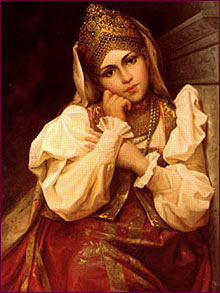 A
technique of pure glazing is also used: glaze, a transparent
layer of paint, is applied all over another color or ground,
so that light passed through it is reflected back by the under-surface
and modified by the glaze. This layering brings out a radiant
quality in the drawings and the colors seem to emanate from
within. Coats of varnish are applied to every layer of paint.
Sometimes, an underlay of gold leaf or mother of pearl enhances
this radiance and adds a lovely iridescence of its own. A
technique of pure glazing is also used: glaze, a transparent
layer of paint, is applied all over another color or ground,
so that light passed through it is reflected back by the under-surface
and modified by the glaze. This layering brings out a radiant
quality in the drawings and the colors seem to emanate from
within. Coats of varnish are applied to every layer of paint.
Sometimes, an underlay of gold leaf or mother of pearl enhances
this radiance and adds a lovely iridescence of its own.
|
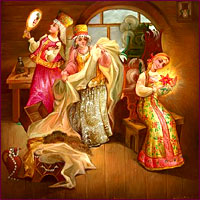 Artists
from Fedoskino use a more realistic style of painting than the
other villages. The most popular themes of Fedoskino lacquered
miniatures include the scenes and sketches of peasant life,
i.e. folk round dances, traditional tea-parties and Russian
"troikas" (three horses harnessed abreast). The school
of painters from Fedoskino is distinguished from other schools
by the lack of graphic and flat manner of painting. They also
use oil paints for their drawings instead of the egg-based temperas.
Three to four layers of the oil paints, along with seven coats
of lacquer, are applied to each box before it is completed. Artists
from Fedoskino use a more realistic style of painting than the
other villages. The most popular themes of Fedoskino lacquered
miniatures include the scenes and sketches of peasant life,
i.e. folk round dances, traditional tea-parties and Russian
"troikas" (three horses harnessed abreast). The school
of painters from Fedoskino is distinguished from other schools
by the lack of graphic and flat manner of painting. They also
use oil paints for their drawings instead of the egg-based temperas.
Three to four layers of the oil paints, along with seven coats
of lacquer, are applied to each box before it is completed.
|
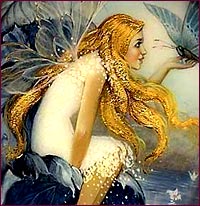 This
art has been known in Russia since the late eighteenth century. This
art has been known in Russia since the late eighteenth century.
The folk artists - painters from Fedoskino, are truly
considered the founders of the Russian lacquerwork. In 1795
Peter Korobov, a rich merchant, opened one of the first workshops
in Fedoskino. Lacquered boxes with painted miniatures became
the first products of that workshop.
Soon the Fedoskino painted boxes became popular and famous
in Russia and in Europe. Later painters from Palekh, Mstera,
Kholui, started to use the technology of lacquered miniature,
creating their own peculiar traditions of miniature painting.
|
|
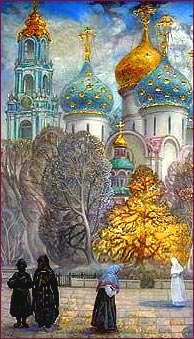 Practically,
the production of lacquered papier-mache articles with painted
decoration has not changed significantly since the mid-nineteenth
century. Practically,
the production of lacquered papier-mache articles with painted
decoration has not changed significantly since the mid-nineteenth
century.
Today the articles are painted with a great variety
of subjects on genre, literary, song, fairy-tale, historical
and contemporary life themes. But even a short acquaintance
with them helps one to go deep into their art, which is an
art unique, with strong national roots and the traditional
decorative quality, which gives it its originality.
At present, there are three hundred painters working
in Fedoskino (totally, there are 2,500 villagers). Many of
them belong to the families, whose members have been painting
miniatures for over 10 generations. Yuri Gusev, a prominent
painter, who invented the logo for the products currently
made in Fedoskino, is the head of the painters community in
the village.
The prices for the lacquered miniatures from Fedoskino
are set depending on the depicted story, materials in use
and the skills of painters. However, many counterfeits are
sold in Izmailovo art market in Moscow and even in some specialized
shops. The real boxes from Fedoskino are light-weighted, the
paintings are fine and sophisticated. The interior should
possess the logo of Fedoskino covered with several layers
of varnish. Each box shoud have a signature of painter.
The boxes made in Fedoskino by special order were
offered as traditional gifts to the heads of states, who visited
the former Soviet Union. Some masterpieces of lacquered miniature
were sold for nearly 100,000 US dollars at the international
fairs.
Those, who managed to get a real box from Fedoskino,
may truly consider themselves the owners of very expensive
pieces of art and, what is more, sophisticated connoisseurs
of traditional Russian culture.

|
|
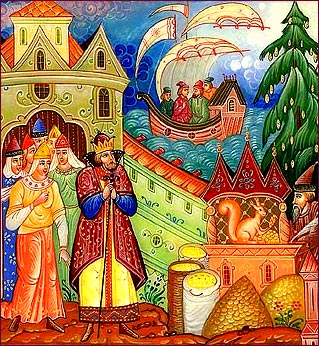
Mstera school of painting "The Tale
of Tsar Saltan". |

|
|
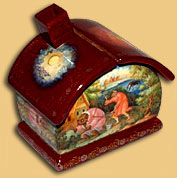 Mstera Mstera
Mstera is a unique place in the eastern Vladimir Region.
Since the 17th century, it has been the Mecca of Russia's
icon painting and other arts and crafts.
Today, Mstera is famous for its lacquer papier-mache
miniatures.
|
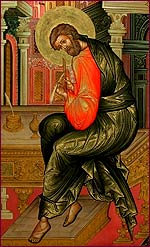 The style of Mstera also derives from the traditions
of Russian icon-painting. It develops and deepens a realist
perception, and displays a variety and subtlety of palette,
being picturesque, ornamental and decorative.
The style of Mstera also derives from the traditions
of Russian icon-painting. It develops and deepens a realist
perception, and displays a variety and subtlety of palette,
being picturesque, ornamental and decorative.
The delicate combinations of color in the main drawing seem
to glitter and glow.
Traditionally the Mstera miniature incorporates cliffs,
small mountains, hills architecturaldetails and fantastic decorative
foliage as its basic forms and themes.
|
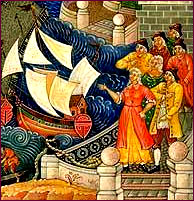 Boxes
from Mstera, usually have the lightest colors. Artists there
almost never choose black for their backgrounds, and instead
use light blue, pink, gold or ivory colors. Boxes
from Mstera, usually have the lightest colors. Artists there
almost never choose black for their backgrounds, and instead
use light blue, pink, gold or ivory colors.
With the addition of these colors, landscapes generally play
a more prominent role in Mstera works, and people and objects
tend to take a place within the background setting rather than
remain separate from it.
|
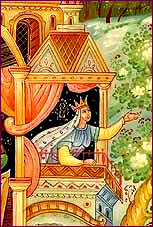 In
Mstera, a wide range of artistic talent exists. While some artists
paint dynamic and elaborate scenes from fairy tales or famous
battles, others concentrate on exquisite floral designs. Mstera
Jeweler is one of the largest factories in Russia based on folk
craft with richest traditions of artistic metalwork, the roots
of which lie in cultural layers, brought to Russia, with the
adoption of Christianity, in the magnificent culture of church
art and icon-painting. In
Mstera, a wide range of artistic talent exists. While some artists
paint dynamic and elaborate scenes from fairy tales or famous
battles, others concentrate on exquisite floral designs. Mstera
Jeweler is one of the largest factories in Russia based on folk
craft with richest traditions of artistic metalwork, the roots
of which lie in cultural layers, brought to Russia, with the
adoption of Christianity, in the magnificent culture of church
art and icon-painting.
|
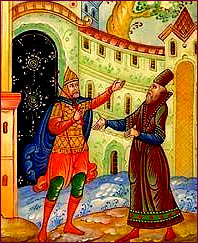 The
craft of Vladimir-Suzdal land had been developing for centuries.
Due to the efforts of individual craftsmen who united themselves
into small artels (cooperatives) at the end of the 19th - beginning
of the 20th century, and they not only laid down the productive
area of the future factory, but also did a lot to outline its
artistic trend. The
craft of Vladimir-Suzdal land had been developing for centuries.
Due to the efforts of individual craftsmen who united themselves
into small artels (cooperatives) at the end of the 19th - beginning
of the 20th century, and they not only laid down the productive
area of the future factory, but also did a lot to outline its
artistic trend.
|
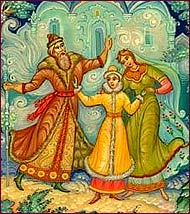 Profound
knowledge of non-ferrous and precious metals processing, great
abilities in blacksmith's and embossing crafts, engraving upon
red and green copper, steel and silver, work with precious stones,
beads and glass, painting with hot enamel against a filigree
background, finesse of painted enamel technique, intricate patterns
of filigree lavishly studded with granulation, this heritage
was not only preserved but also found broad use in the modern
art of master jewelers. Profound
knowledge of non-ferrous and precious metals processing, great
abilities in blacksmith's and embossing crafts, engraving upon
red and green copper, steel and silver, work with precious stones,
beads and glass, painting with hot enamel against a filigree
background, finesse of painted enamel technique, intricate patterns
of filigree lavishly studded with granulation, this heritage
was not only preserved but also found broad use in the modern
art of master jewelers.
|
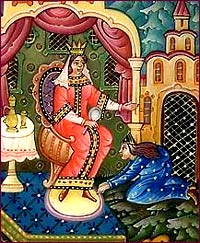 The
production of Mstera jewelers is well known in Russia and abroad. The
production of Mstera jewelers is well known in Russia and abroad.
It is widely used in modern household and is in great
demand. The talented artists and masters of the factory preserve
the best traditions of Mstera jewelry craft and create new and
unique works of art.
|
|
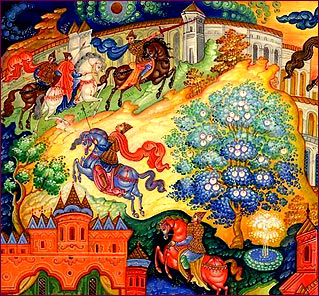
Books:
- "200 years of Russian Lacquery", Yantarny Skaz,
Roskniga, 1996, Kaliningrad, L. Pirogova, 5-7406-0017-0
- "The Art of Soviet Palekh", Moscow: 1958,Russian/French/English
text by N. Sobolevsky.
|
|



